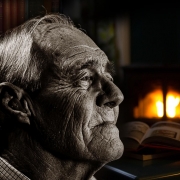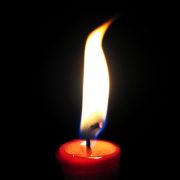In Memory of John Yeowell – “Stubba” (1918-2010)
By Heimgest DCG
On 25th Shedding 2260re one of our founding members, John Yeowell, better known as Stubba in Odinist society, passed from this realm at the age of 92.
Not only did he enjoy a long life, but a full one including military service which began with service in an Irish division, then a stint in the French Foreign Legion for which he was decorated by General Charles DeGaulle. From there he signed up with the British forces and was a Chindit. At the end of WWII, he returned to the Foreign Legion before leaving military service in the early 1950s and returning to his native England.
Much of Yeowell’s life was rather a mystery, something he did his best to maintain, but among other interests was his leading role in the neo-Jacobite Royal Stuart Society as well as a host of other committees and societies. It wasn’t however until the late 1950s that he met the man who was to awaken him to Odinism. That man was John Gibbs-Bailey, known as Hoskuld to Odinists.
Gibbs Bailey, being at least a decade older than Yeowell, had been an Odinist since the 1930s and by the time the two met had been involved in a number of proto-Odinist and Odinist groups. Though their initial meeting had been more due to a cultural rather than religious interest, their conversations touched on religious topics and in time, Yeowell , who had been born and raised a Catholic (albeit a lapsed one) realised that Odinism was the natural religion for those of Northern Indo-European stock and he embraced the faith. Their association and friendship grew and in time they began to formulate ideas for the setting up of an organised Odinist group and together began laying the foundation for one.
In 1973, believing they had a solid framework on which to build, they launched The London Odinist Committee for the Restoration of the Odinic Rite, an unwieldy name, though technically accurate for the time and likely reflecting Yeowell’s methodical and structured approach. It was usually abbreviated to The Odinist Committee. In 1980 it was deemed that the Odinic Rite was more suitable and the excess title wording was dropped.
It should be understood that the Odinic Rite did not suddenly just appear in 1973, its roots were long and deep. There was Hoskuld’s four decades of experience which served as a valuable source for what became the Nine Charges and Nine Noble Virtues and also a collection of proto-rituals. One of Yeowell’s main talents was his methodical approach and his ability to collate and refine masses of information. His previous careers and interests equipped him well for the kind of ground laying admin work that is needed to ensure a solid base on which a movement could grow and so this ability was put to work to develop the OR. Both men had also spent many, many hours looking at previous Odinic and proto-Odinic groups (many of which Hoskuld had been involved in) and defined what guidelines and regulations were needed to create the solid foundation on which to build. Hoskuld had brought 8 of the nine charges with him, but I believe it was Stubba who suggested they added another so the holy number 9 of Odinism was reflected in this “Odinic Creed”. The idea of an Odinic dating system (detailed in ORB 217) was included as well as the names of the months the OR were to use. Details such as this, while seemingly minor, are in fact the small details which build a solid foundation.
Stubba also devoted a lot of time to the mass of administrative aspects of organising a movement and was responsible for producing the OR publications of the time, which along with OR Briefing (then a single A4 sheet, typewritten and Xeroxed) included Raven Banner, as well as a couple of booklets and flyers. In these early days especially, it was his methodical and orderly manner of doing things which was needed, so his experience with committees, study groups, etc, was very beneficial to the building of the OR. He of course hosted Hearth moots and dealt with the vast majority of correspondence.
Due to the ill health of Hoskuld and his wife, it was Yeowell who was decided upon as the overt partner of the two. He took the Odinist name of Stubba and became the first Director of the Court of Gothar. Some have wondered why he chose the name Stubba and one or two odd theories have been posited. The reality is that as well as another home, Stubba had a house on the Whitechapel/Stepney border, an area of East London. Though not a native of this area, in true form he studied up on the area, its history and development and so forth. He found that its history stretched way back, but of most interest and importance to him was the fact that the name of the area, derived from an Anglo Saxon chieftain: Stybba. So he decided upon this name as his Odinic name. Stubba guided the OR through its early years in a cautious manner, not attempting to try to rush forward impetuously. Instead, this painstaking approach gave the chance to lay solid foundations. Another of his talents was in writing to newspapers and various authorities on a wide range of matters while presenting the Odinic view on the subject he wrote on. He studied a very wide range of publications, gleaning information which he felt may be of use to the OR sometime or looking for issues which could receive an Odinist slant. Contacts were made with the few other adherents of our faith that were known, most notably Else Christensen.

An enormously widely read man, he built an extensive library and sought out works pertaining to our religion. In time he built a wonderful Odinic library but, alas this was later lost.
One of the most significant initiatives Stubba undertook was to research the history of tribes who arrived in Britain and by conquest created England. The tribes still followed their indigenous religion and had not been “converted” and suppressed by the middle eastern religion of Judeo Christianity, so they were in fact Odinists (though of course the title was not used then) and so the new nation they forged, was an Odinic nation and as such so many of the traditions still celebrated in the United Kingdom today, have their direct roots firmly in our holy eternal faith. This led him to discover and research the White Horse Stone legend. As a young man he had apparently come across this stone while hiking across Britain and its significance moved him and stirred something deep within him, though it was many years before he understood the call of his ancestral faith. The White Horse Stone could be regarded as the birth place of England and as those ancestors of ours were Odinists, it would be a very fitting place for us to reclaim as a holy site. Those who were there will remember this wonderful occasion. The blot to reclaim and make holy this site and to rededicate the land to the Odinist gods and goddesses was a very profound event and of course since then the White Horse Stone has become one of the most sacred sites in Odinism. Since its reclamation it has of course seen Professions, hand-fastings, namings, and bael ceremonies as well as countless other OR blots that have been held there. Stubba coordinated the first campaign of defence for this site when the channel tunnel rail link was planned to pass straight through the site and destroying not only the beauty of the area but the Stone itself in the process. So it can be seen that he played a major role in laying down the basic foundations of the Odinic Rite and leading it in its’ formative years as the first DCG.
In 1989ce he felt the time had come for him to step down from this post and Heimgest was then installed as the new DCG after a unanimous decision of the CG.
Like all movements, there are times when conflicts arise, not just external but internal, and after the successful laying of the basic foundations, it is perhaps ironic that when the OR began to make greater advances, such a conflict arose. Within weeks of Heimgest’s installation as the Rite’s leader, came a period of mounting tensions. This is not the place to detail this period of conflict, suffice to say it led to the expulsion of some members. This was the period which saw the attempt by a couple of those removed, to create an entirely bogus OR. Stubba was one of those involved in this. Had this plot been a success, then the Odinic Rite likely would not exist today. As it was, the genuine Odinic Rite not only survived this period of storm but flourished greatly. After four years, Stubba realised he had made a serious error and contacted the Court of Gothar to ask if CG representatives would meet with him to discuss matters. This was arranged and to his great credit he fully admitted that he had made a terrible mistake in becoming involved with the scheme to create a bogus OR, and all that went with that, and that he deeply regretted his involvement. He did not try to make excuses and fully accepted he had been wrong. He asked if he would be able to return to the Odinic Rite. This request was accepted by the Court of Gothar and as the CG representatives and he shook hands on this he smiled broadly and said “Its good to be home again”. So once again he could use the initials OR after his name and once more he worked for the advance of the Odinic Rite, the movement he had played such an important role in creating. By this time he was in his 70s and not in the best of health, so his level of activity was of course greatly reduced.
Stubba had expressed his wish to have his ashes scattered in an Odinic Rite ceremony at the White Horse Stone. It is very fitting that the man who initiated the campaign to reclaim this holy site for our religion and folk will have his mortal remains scattered there in an OR ceremony.
A full, long and active life with many paths trodden, but we can remember him as one of the two who founded the OR. Those who met him will remember that he was an English gentleman in the old school way, with a ready wit and charm, and of course we can remember the good that he did, and so we salute him.
In the next realm and next life, fare you well Stubba!
On Thursday the 14th July a Bael ceremony was conducted at the White Horse Stone for Stubba, a founder member of the OR, who passed away earlier this year. His ashes were brought down to the WHS by friends and his God-daughter.
The ceremony was conducted by Asrad CG and Stubba’s ashes were scattered at the base of the WHS by his friends. The ceremony was powerful and well received by Stubba’s friends, one of whom sent an email thanking us for the ceremony and our work in keeping the WHS protected and cared for.


